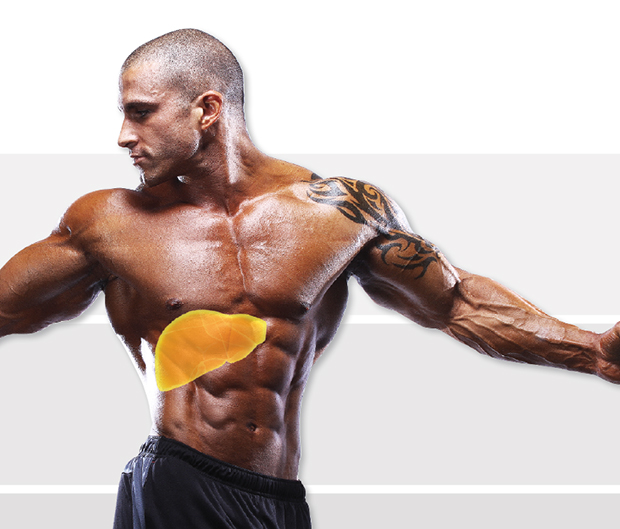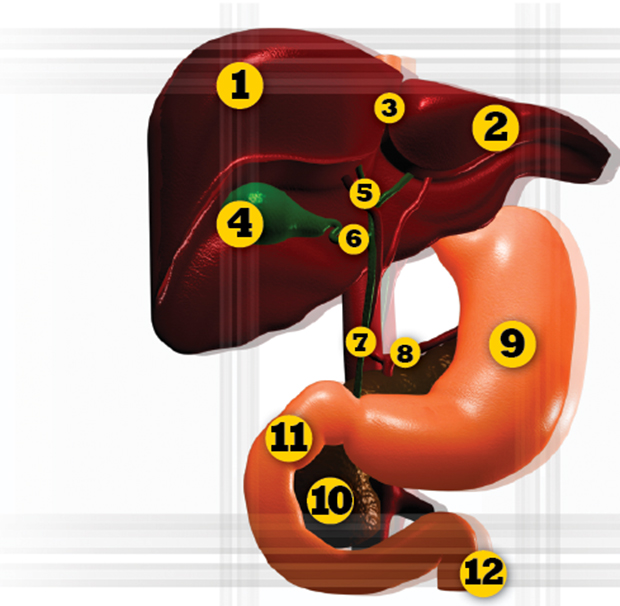How To Detox Your Liver

When was the last time you thought about detoxifying your liver? If the thought hasn’t crossed your mind in the past 24 hours, now would be a perfect time to start! Your liver is like a garbage truck: it picks up and removes waste—except it does so 24 hours a day, seven days a week, 365 days a year! Detoxification is a full-time job, but it doesn’t have to feel like one. You can easily and effectively facilitate detoxification through the consumption and supplementation of liver-friendly nutrients. Combine this with consistency and you’re well on your way to cutting fat—for good.
MEET YOUR LIVER, the most overworked and underpaid organ of the body. It’s responsible for many vital functions, such as metabolizing proteins, carbohydrates, and fats; storing nutrients such as vitamins, minerals, and glycogen (the muscles’ preferred source of post-workout fuel); regulating blood sugar; producing and excreting bile; filtering blood and, last but not least, removing toxic waste material. Toxic waste consists of endotoxins (the waste that comes from within us, such as oxidized fats and cholesterol, free radicals, and other irritating molecules) and exotoxins (the waste that comes from outside of us through diet, drug use, and environmental exposure). Since your liver is constantly working overtime, it’s constantly exposed to insult, injury, and disease. On that account, you should pay attention to it daily to facilitate waste removal.

LIVER DETOXIFICATION 101
Detoxification, the process of clearing toxins through dietary and lifestyle change, is critical if your end result is fat loss. Although many organs assist with waste removal, the most important is the liver, which detoxifies in a two-phase arrangement called the cytochrome P450 system.
Phase I—THE OXIDATION PHASE
When toxins enter the body, they’re stored in fat cells, nerves, the brain, the kidneys, and other tissue. In Phase I, the liver’s key playing enzyme, cytochrome p450, pulls the toxins out of storage and neutralizes them through three reactions: oxidation, reduction, and hydrolysis. As crazy as this sounds, existing toxins become more toxic from the three reactions to better prepare them for phase II, which is where the body will begin to eliminate them.
Phase II—THE CONJUGATION PHASE
During the second phase, toxic substances are prepared to be disarmed and excreted from the body through four main types of conjugation: glutathione conjugation, sulphation, glucuronidation, and glycine conjugation. Once conjugated, the toxins are rendered less harmful and are excreted from the body through bile or urine.

POOR LIVER FUNCTION? YOU MUST TAKE HEED.
When your liver is clogged up and filled with junk, it can’t carry out the vital function of fat metabolism. Because of this, a host of problems can develop, such as cardiovascular disease, high cholesterol, type 2 diabetes, and autoimmune disease. Moreover, the function of the thyroid gland, a large ductless gland in the neck, is greatly influenced by the liver and how well it is working. The thyroid secretes hormones to regulate growth and the rate at which we burn calories. If your liver is congested, it can become difficult for your thyroid to regulate metabolism; this will only make matters worse for your waistline!
WHEN SHOULD ONE DETOX?
Since detoxification is key for fat loss, everyone should try to facilitate its process daily. Just how toxic you are is dependent on your past and current diet as well as your lifestyle. Want to find out just how toxic you are? Complete the checklist to see your detox ability!
- Do you have bad breath?
- Do you often suffer from headaches or migraines, or joint or muscle aches and pains?
- Do you sometimes have watery or itchy eyes or swollen, red, or sticky eyelids?
- Do you suffer from excessive mucus, a stuffy nose, or sinus problems?
- Do you have itchy ears, earache, ear infections, drainage from the ears, or ringing in the ears?
- Do you suffer from acne or skin rashes or hives?
- Do you sweat a lot or have strong body odor?
- Do you have a sluggish metabolism and find it hard to lose weight, or are you underweight and find it hard to gain weight?
- Does coffee leave you feeling jittery or unwell?
- Do you easily get a hangover and feel considerably worse the next day even after a small amount of alcohol?
If you answered “yes” to fewer than three of these questions, you’re unlikely to have a problem with detoxification. If you answered “yes” to three or more, you’re showing poor signs of detoxification and need to improve your ability to detox.

LIVER-LOVING NUTRIENTS
How effectively you detox depends entirely on you. Because detoxification is work, it requires energy for its process to be successful, so it’s important to continuously provide your body with a great supply of nutrients. Listed below are the key nutrients needed to support liver detoxification and fat loss.
- Vitamin A (Retinol and Beta-Carotene) - Antioxidant found in beef and veal liver, fish, eggs
- B Vitamins - Involved in energy production for detox whole grains, dark leafy green vegetables, legumes, blue-green algae
- Vitamin C - Antioxidant found in fresh fruits (citrus) and vegetables (broccoli, beets)
- Vitamin E - Antioxidant found in raw sunflower seeds, sesame seeds, tuna, salmon and sardines
- Magnesium - Mineral found Dark green vegetables, beets, nuts, seeds, legumes, avocado
- Selenium - Antioxidant that's part of liver protectant enzyme, glutathione Brazil nuts, whole grains, broccoli, garlic, onions, fish
- L-Glutamine - Supports health of digestive tract membrane Meat, fish, dairy, beans
- Glutathione - The “master antioxidant” required for glutathione pathway Raw milk, cruciferous vegetables, garlic, onions, parsley, eggs
- Indole-3-Carbinol - Modifies “bad estrogen,” activates Phase I and II Cruciferous vegetables (broccoli, cabbage, cauliflower)
- Freshwater Algae - Absorbs toxins in digestive tracts, great supply of vitamins and minerals, supports immune function Chlorella, spirulina
- Milk Thistle (Silymarin) - Increases bile flow from the liver and gallbladder Available in teas or tincture
- Dandelion - Rich in potassium, diuretic and relieves inflammation of the liver and gallbladder. Found in fresh leaves and roots in teas or tinctures
 Although many people are quick to follow a regimented detox program available at most holistic dispensaries and nutrition stores, it may overcomplicate your fat-loss goals. Without supervision, detoxification can become uncomfortable as toxins may be released from the body too fast. Symptoms such as headaches, fatigue, diarrhea, irritability, and lightheadedness can result from this, and many give up on facilitating detox before it’s over! Keep it simple for compliance and optimal results by adding more of these key nutrients to your diet. It’s a guarantee that you’ll be on your way to a lean liver and an even leaner you!
Although many people are quick to follow a regimented detox program available at most holistic dispensaries and nutrition stores, it may overcomplicate your fat-loss goals. Without supervision, detoxification can become uncomfortable as toxins may be released from the body too fast. Symptoms such as headaches, fatigue, diarrhea, irritability, and lightheadedness can result from this, and many give up on facilitating detox before it’s over! Keep it simple for compliance and optimal results by adding more of these key nutrients to your diet. It’s a guarantee that you’ll be on your way to a lean liver and an even leaner you!
For more articles about detoxing your liver, click here!

